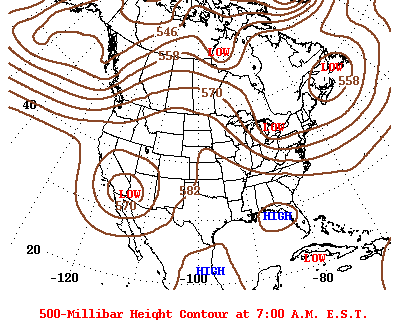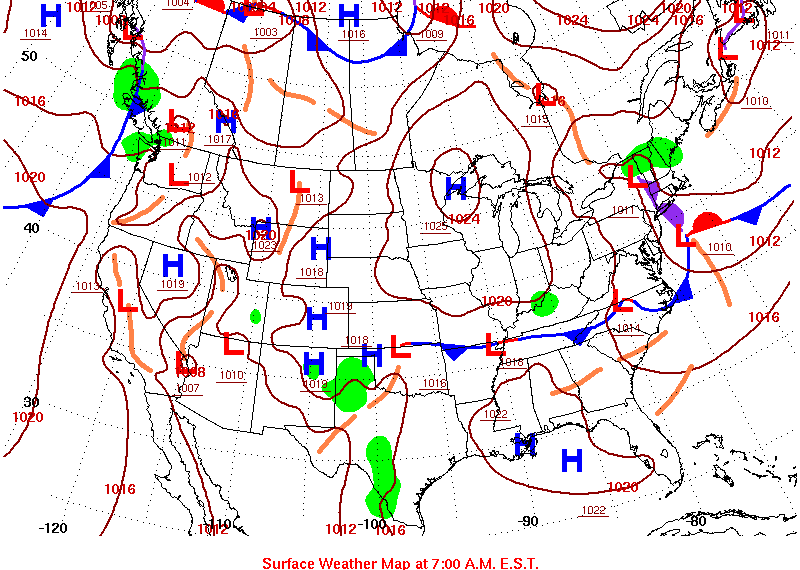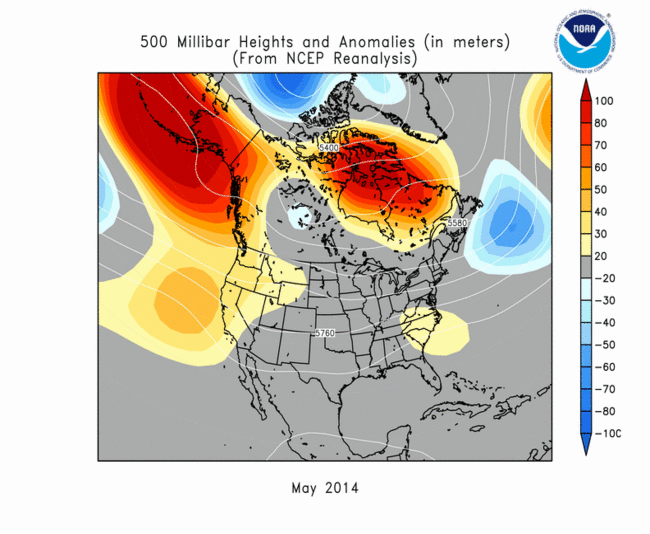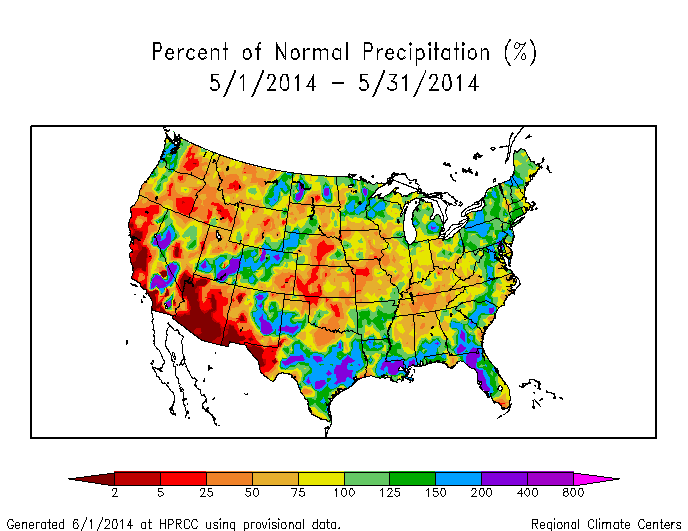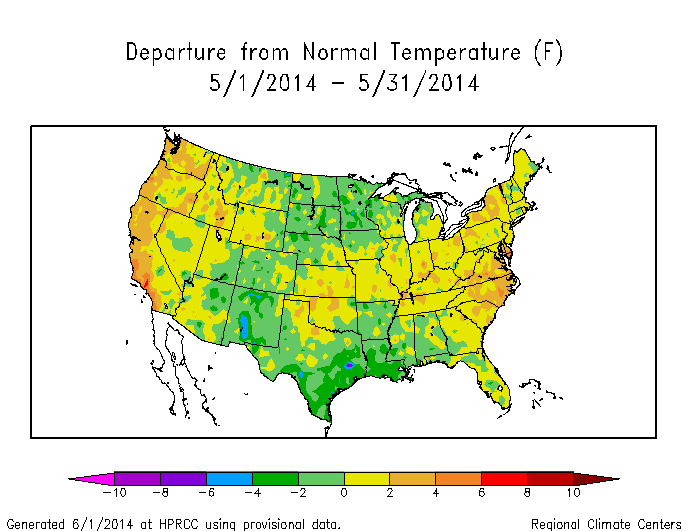Note: This Synoptic Discussion describes recent weather events and climate anomalies in relation to the phenomena that cause the weather. These phenomena include the jet stream, fronts and low pressure systems that bring precipitation, high pressure systems that bring dry weather, and the mechanisms which control these features — such as El Niño, La Niña, and other oceanic and atmospheric drivers (PNA, NAO, AO, and others). The report may contain more technical language than other components of the State of the Climate series.
Summary
May marks the end of climatological spring, which is the season of transition from the atmospheric forcings of winter to a new set of forcings behind summer. This change was reflected by the seasonal migration northward of the circumpolar vortex and increasing influence of the subtropical high pressure centers and high pressure anomalies, but the numerous large short-wave troughs and lows traversing the contiguous U.S. in a fast westerly flow indicated that the cold season was reluctant to depart. The upper-level circulation pattern still reflected the influence of the West Pacific (WP) mode of variability associated with conditions in the North Pacific. The WP's teleconnections include colder-than-normal temperatures in the north central U.S. and warmer-than-normal temperatures in the Southwest, although signs of the influence of other modes of circulation were evident in the precipitation anomaly patterns. The short-wave troughs generated areas of heavy precipitation in the south and east, and some produced severe weather when slowed by blocking patterns in the atmospheric circulation. The circulation pattern inhibited precipitation across much of the West and Plains to Appalachians, but overall the national drought footprint contracted slightly. Dry weather in the central U.S. contributed to the growth of several large wildfires. See below for details.
Synoptic Discussion
|
In the Northern Hemisphere, May is at the end of climatological spring which is the time of year when solar heating forces the jet stream and circumpolar vortex to contract poleward. Cold polar air masses can still influence the weather, but they are not as cold as in previous months. The warm, dry subtropical high pressure belt begins to exert more influence as it shifts northward, with warm southerly air masses moving into the contiguous United States (CONUS) more frequently. In May 2014, a strong westerly flow in the upper-level circulation sent several weather systems rippling across the CONUS, but the North Pacific and North Atlantic subtropical high pressure centers helped to poke warm ridges into the jet stream flow. Occasionally the upper-level trough/ridge pattern would stall and amplify, with upper-level lows and troughs moving slowly across a region. |
|
These upper-level weather systems generated low pressure systems with their associated warm and cold fronts at the surface — warm air flowed ahead of the lows, with cold air surging southward behind them. There were slightly more record warm daily highs and lows (3275) as record cold daily highs and lows (2937), but the roughly equal number of daily extremes associated with the parade of competing cold and warm air masses (weeks 1, 2, 3, 4, 5) resulted in a monthly temperature anomaly pattern where monthly extremes were mostly washed out. Averaged across the nation, May 2014 ranked as the 32nd warmest May in the 1895-2014 record. Since the cold was focused more on the less populated interior of the U.S., the May 2014 REDTI (Residential Energy Demand Temperature Index) ranked as the eleventh lowest May REDTI in the 120-year record. Severe weather developed from the Plains eastward in association with these weather systems, with several major outbreaks occurring during the month. Tornadoes occurred across the country throughout the month in the unstable air ahead of the slow-moving upper-level troughs, but the preliminary count of 150 tornadoes was well below the average count of 276 tornadoes for May. The slow-moving nature of some of the short-wave weather systems traversing the upper-level flow brought heavy precipitation to parts of the country, especially the Gulf of Mexico coast. The haphazard character of the slow-moving upper-level systems split the storm track east of the Rockies, resulting in drier-than-normal weather from the Southern Appalachians to Central Plains, where Kansas had its sixth driest May on record, and contributing to the occurrence of large wildfires in these regions early in the month. Ridging in the upper atmosphere dominated in the West, bringing mostly below-normal precipitation and above-normal temperatures, with May 2014 ranking as the ninth warmest May for California. Drought expanded in some areas, but beneficial rains from the upper-level lows and cold fronts contracted drought in others, with the net change being a decrease in the national drought footprint compared to the end of April. |
|
When integrated across the month, the circulation produced a pattern of above-normal 500-mb heights (stronger-than-normal long-wave ridge) over western North America, the southeastern U.S., and northeast Canada, and below-normal 500-mb heights (stronger-than-normal long-wave trough) over west-central Canada. The above-normal anomalies in the west and southeast reflected the dominance of long-wave ridging in the jet stream and the influence of the subtropical high pressure centers. The below-normal anomalies over west-central Canada reflected the lingering dominance of troughs at the jet stream level as the circumpolar vortex continued its seasonal retreat northward. |
|
Above-normal precipitation fell in a ring along the Gulf of Mexico coast, central Atlantic coastal plains, Northeast, Great Lakes, and Central to Southern Rockies. This "above-normal ring" surrounded a vast area of below-normal precipitation from the Central Plains to Southern Appalachians. Conditions were mostly drier than normal across the West, but parts of the West had above-normal precipitation, although normals are low this time of year. Upper-level ridging associated with above-normal 500 mb heights brought dry weather to much of Alaska, while Hawaii was generally wetter than normal in the northern islands and drier than normal in the south. |
|
While the roller coaster pattern of warm fronts and cold fronts traversing the CONUS kept monthly temperatures from getting too extreme, a distinct monthly temperature anomaly pattern was evident. Near normal to below normal temperatures dominated the middle third of the country, reflecting frequent cold frontal passages, while above-normal temperatures along the west and east coasts are associated with the dominance of upper-level ridging. The western North America ridge brought above-normal temperatures to Alaska, resulting in the sixth warmest May in the state's 1918-2014 record. |
The upper-level circulation over North America is part of the hemispheric mid-latitude westerly circulation. The circulation anomalies during May form an interconnected meridional pattern with the anomalies over Eurasia and the North Pacific and North Atlantic oceans, consisting of paired above-normal and below-normal 500-mb height anomalies over the continents and oceans. Compared to April, the pattern of anomalies in May reflects a significant seasonal shift toward the pole of the positive anomalies and a weakening of the negative anomalies. Consequently, there were large areas of warmer-than-normal temperatures across the Northern Hemisphere associated with the above-normal 500 mb heights, and pockets of below-normal precipitation.
Atmospheric Drivers
Subtropical highs, and fronts and low pressure systems moving in the mid-latitude storm track flow, are influenced by the broadscale atmospheric circulation. The circulation of the atmosphere can be analyzed and categorized into specific patterns. The tropics, especially the equatorial Pacific Ocean, provides abundant heat energy which largely drives the world's atmospheric and oceanic circulation. The following describes several of these modes or patterns of the atmospheric circulation, their drivers, the temperature and precipitation patterns (or teleconnections) associated with them, and their index values this month:
-
El Niño Southern Oscillation (ENSO)
- Description: Oceanic and atmospheric conditions in the tropical Pacific Ocean can influence weather across the globe. ENSO is characterized by two extreme modes: El Niño (warmer-than-normal sea surface temperature [SST] anomalies in the tropical Pacific) and La Niña (cooler-than-normal SST anomalies), with the absence of either of these modes termed "ENSO-neutral" conditions.
- Status: Ocean temperatures and atmospheric circulation anomalies indicated that the equatorial Pacific continued in an ENSO-neutral state during May. The equatorial Pacific SST anomalies continued to warm with the development of an El Niño, but the collective atmospheric and oceanic conditions continued to reflect ENSO-neutral.
- Teleconnections (influence on weather): To the extent teleconnections are known, while in a neutral state, ENSO normally is not a player in the month's weather. Historical data has been analyzed by NOAA to show typical temperature and precipitation patterns associated with El Niño and La Niña ENSO episodes. Teleconnections are not available for ENSO-neutral conditions at that NOAA web site. If an El Niño were happening during May, the typical precipitation pattern would consist of wetter-than-normal conditions along the Gulf Coast and Southeast, near-normal to wet conditions in the Southwest, and drier-than-normal conditions across much of the northern half of the CONUS.
- Comparison to Observed: The May 2014 precipitation anomaly pattern is similar to that expected with an El Niño, except in the Southwest.
-
Madden-Julian Oscillation (MJO)
- Description: The MJO is a tropical disturbance or "wave" that propagates eastward around the global tropics with a cycle on the order of 30-60 days. It is characterized by regions of enhanced and suppressed tropical rainfall. One of its indices is a phase diagram which illustrates the phase (1-8) and amplitude of the MJO on a daily basis. The MJO is categorized into eight "phases" depending on the pattern of the location and intensity of the regions of enhanced and suppressed tropical rainfall. The MJO can enter periods of little or no activity, when it becomes neutral or incoherent and has little influence on the weather. Overall, the MJO tends to be most active during ENSO-neutral years, and is often absent during moderate-to-strong El Niño and La Niña episodes.
- Status: The MJO started the month in phase 8, transitioned to phases 1 and 2 as the month progressed, then became weak and incoherent, finally ending the month weakly in phase 2. The MJO indices appeared to be influenced by other modes of coherent subseasonal tropical variability, including Kelvin and Rossby waves and the developing background state related to the transition to El Niño (as indicated by the MJO discussions for May 5, 12, 19, 26, and June 2).
- Teleconnections (influence on weather): The MJO's temperature and precipitation teleconnections to U.S. weather depend on time of year and MJO phase. To the extent teleconnections are known, the April-June teleconnections for precipitation are shown here and for temperature are shown here.
- Comparison to Observed: The MJO is transitory and can change phases (modes) within a month, so it is more closely related to weekly weather patterns than monthly. But for May 2014, there seems to be little correspondence on the weekly level and some degree of correspondence at the monthly level. The May 2014 monthly precipitation anomaly pattern matches phases 8-2 in some areas, while the monthly temperature anomaly pattern agrees with the phase 1 teleconnections in the middle third of the CONUS.
- The Pacific/North American (PNA) pattern
- Description: The PNA teleconnection pattern is associated with strong fluctuations in the strength and location of the East Asian jet stream. PNA-related blocking of the jet stream flow in the Pacific can affect weather downstream over North America, especially the West and especially in the winter half of the year.
- Status: The daily PNA index was near zero for the first two-thirds of the month then negative for the last third, averaging negative for the month as a whole.
- Teleconnections (influence on weather): To the extent teleconnections are known, the temperature teleconnection map for a negative PNA at this time of year (April on the maps) shows below-normal temperatures in the Pacific Northwest, Alaska, and most of Canada, and above-normal temperatures across the Southern Plains to Southeast. The precipitation teleconnection map for this time of year shows wetter-than-normal conditions in the Upper Mississippi Valley and drier-than-normal weather in Colorado to Kansas (although the teleconnections for precipitation are weak). The upper-level circulation anomaly teleconnection for a negative PNA shows below-normal heights over most of Canada and above-normal heights over the southeastern third of the CONUS. A positive PNA is associated with the opposite patterns.
- Comparison to Observed: The May 2014 temperature and upper-level circulation anomaly patterns do not agree with that expected with a negative PNA, while there is some agreement in the precipitation anomaly pattern in Kansas.
- The Arctic Oscillation (AO) pattern
- Description: The AO teleconnection pattern relates upper-level circulation over the Arctic to circulation features over the Northern Hemisphere mid-latitudes and is most active during the cold season.
- Status: The daily AO index began the month positive, then became neutral (near zero), averaging positive for the month.
- Teleconnections (influence on weather): To the extent teleconnections are known, a positive AO this time of year (April-June) is typically associated with dry conditions from the Northeast to Mid-Atlantic, and westward to the Central to Northern Rockies, small pockets of above-normal precipitation along the western Gulf of Mexico coast and in the Southeast, above-normal temperatures from the Central Rockies to the Great Lakes, and upper-level circulation anomalies which are below normal over northern Canada and Alaska and above normal over the central to northeast CONUS and much of the North Pacific.
- Comparison to Observed: The May 2014 upper-level circulation anomaly pattern is similar to that expected with a positive AO over parts of the North Pacific, but not over North America. The precipitation anomaly pattern agrees from the Appalachians to Great Plains, but not elsewhere. The monthly temperature anomaly pattern shows little resemblance to that associated with a positive AO.
- The North Atlantic Oscillation (NAO) pattern
- Description: The NAO teleconnection pattern relates upper-level circulation over the North Atlantic Ocean to circulation features over the Northern Hemisphere mid-latitudes.
- Status: The daily NAO index began May slightly negative, then turned neutral (near zero) for the last half of the month, averaging negative for the month.
- Teleconnections (influence on weather): To the extent teleconnections are known, a negative NAO during this time of year (April on the teleconnection maps) is associated with cooler-than-normal temperatures across most of the CONUS, near normal temperatures over Alaska, wetter-than-normal conditions across the Southeast and in parts of the West and Central Plains, near normal precipitation across Alaska (although the teleconnections are weak for precipitation), and negative upper-level circulation anomalies across the CONUS.
- Comparison to Observed: The May 2014 monthly precipitation anomaly pattern agrees over the Southeast, but not elsewhere. The temperature and upper-level circulation anomaly patterns generally do not match over the CONUS, although there is some correspondence over the North Atlantic for the upper-level circulation.
- The West Pacific (WP) pattern
- Description: The WP teleconnection pattern is a primary mode of low-frequency variability over the North Pacific and reflects zonal and meridional variations in the location and intensity of the (East Asian) jet stream in the western Pacific.
- Status: The monthly WP index was negative for the month, with the three-month average WP index negative as well.
- Teleconnections (influence on weather): To the extent teleconnections are known, a negative WP during this time of year (April on the maps) is typically associated with above-normal temperatures in the Southwest, below-normal temperatures in the Northern Plains to Midwest, wetter-than-normal weather in coastal Washington (although the precipitation teleconnections in general are very weak), above-normal circulation anomalies over the Southwest, and below-normal circulation anomalies over the Northern Plains into central Canada.
- Comparison to Observed: The May 2014 monthly temperature, precipitation, and upper-level circulation anomaly patterns are a good match to a negative WP in the CONUS where teleconnections exist.
- The East Pacific-North Pacific (EP-NP) pattern
- Description: The EP-NP teleconnection pattern relates SST and upper-level circulation patterns (geopotential height anomalies) over the eastern and northern Pacific to temperature, precipitation, and circulation anomalies downstream over North America. Its influence during the winter is not as strong as during the other three seasons.
- Status: The SST pattern over the northeastern North Pacific during May 2014 saw a continuation of the warmer-than-normal SSTs there, with the magnitude of the warmth increasing. The monthly EP-NP index has been positive since October, pulling the 3-month running mean well into positive territory. The May value was also positive, reflecting a strengthening of the index since April. The positive phase of the EP-NP pattern is associated with above-average surface temperatures over the northeastern Pacific (thus, the negative phase is associated with below-normal SSTs).
- Teleconnections (influence on weather): To the extent teleconnections are known, a positive EP-NP index during this time of year (April on the maps) is typically associated with cooler-than-normal temperatures across the U.S. east of the Rockies, warmer-than-normal temperatures along the immediate West Coast and in Alaska, wetter-than-normal conditions in the vicinity of Wyoming and parts of the Ohio Valley (although the precipitation teleconnections are weak), below-normal upper-level circulation anomalies (stronger upper-level trough) over the eastern half of Canada and the northeastern CONUS, and above-normal upper-level circulation anomalies (stronger upper-level ridge) over western Canada and Alaska and extending weakly into the western CONUS.
- Comparison to Observed: The May 2014 temperature and upper-level circulation anomaly patterns agree in the western and central CONUS and Alaska, but not in the east. The precipitation anomaly pattern does not match.
Examination of these circulation indices and their teleconnection patterns, and comparison to observed May 2014 temperature, precipitation, and circulation patterns, suggest that, as has been the case for the last several months, the weather over the CONUS in May was most closely related to the jet stream and ocean-atmosphere interactions over the North Pacific Ocean. ENSO was neutral, but equatorial Pacific oceanic conditions were slowly evolving toward an El Niño state, which was affecting the MJO. Even though ENSO was neutral, the May precipitation anomaly pattern was characteristic of that expected with an El Niño in some areas, and the MJO appeared to have exerted some influence on temperature and precipitation. The teleconnections for the NAO match May's precipitation patterns along the Gulf of Mexico coast, but not elsewhere, so the match could have been coincidence. Likewise, the AO teleconnections match for precipitation in parts of the country, but don't match for temperature, so the match could have been coincidence. The PNA index shows essentially no significant correlation to the May weather patterns. It is the North Pacific indices which have the best correlations — EP-NP and WP with the May temperature and circulation anomaly patterns. But the poor agreement in the east for the EP-NP suggests that the WP had the strongest influence. The WP shows some agreement with the precipitation anomaly pattern where teleconnections exist, but so do the MJO, AO, and NAO. It should be noted that precipitation relationships with these indices are generally weak. This month illustrates how the anomaly patterns can be strongly represented by an index (WP) measuring one atmospheric driver (the North Pacific Ocean) for circulation and temperature but also have elements of several other drivers (or modes of atmospheric variability), and how precipitation can be a reflection of several of the drivers.
 NOAA's National Centers for Environmental Information
NOAA's National Centers for Environmental Information
